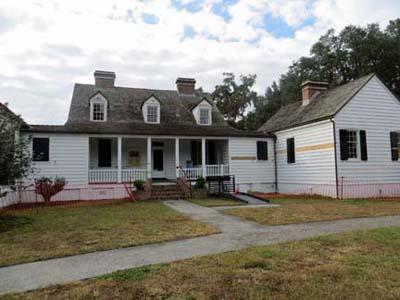Some people discover national park sites that even the natives don’t know about. When I told locals in Charleston, South Carolina, that we were visiting national parks around the city, I got a blank look. “Fort Sumter and Fort Moultrie,” I said and they recognized those.
But Charles Pinckney National Historic Site? What is that?
Charles Pinckney National Historic Site is about six miles northeast of Charleston in Mount Pleasant. Here on 28 acres are the remains of "Snee Farm," Charles Pinckney’s summer home.
Charles Pinckney (1757-1824), a fourth-generation Pinckney, enlisted in the South Carolina militia during the Revolutionary War. When Charleston fell to the British in 1780, Charles Pinckney, a lieutenant, was captured and held prisoner until June 1781. Also captured during the war were Generals William Moultrie and Charles Cotesworth Pinckney, our Charles' cousin, and they were paroled at Snee Farm.
Later, Charles Pinckney became a South Carolina delegate of the Constitutional Convention. Nicknamed "Constitution Charley," he helped shape the Constitution, though exactly how much is still a subject of debate by historians.
He also was elected twice as South Carolina governor. In between his two separate stints as governor, he was the ambassador to Spain. He worked for ratification of the Constitution in South Carolina, which occurred in 1788. At the historic site you'll find an 18-minute film that explains Pinckney’s life and his contribution to the writing of the Constitution.
The Snee Farm was purchased by Charles' father in 1754, and in 1782 Charles inherited the 715-acre property along with its 40 slaves, who tended to fields of indigo, rice, and later cotton. But Pinckney was too busy to give Snee Farm the attention it deserved. In 1817, he had to sell the farm to payoff his debts. However, he was hardly homeless since he owned an elegant townhouse in Charleston where he spent most of his time.
The Pinckney farmhouse was torn down around 1828 when the new owners built the current house. But archeologists worked for years to find where Pinckney's original house stood. In the process, they found pieces of pottery from China and even a homemade toothbrush. Further back, on a short trail, the outlines of slave quarters are squared off in brick.
Today visitors can tour the ground floor of the house. Its walls are covered with posters on Pinckney, slavery and life in South Carolina during the early days of the United States. Rangers and volunteers are very quick to answer questions and engage in lively discussion.
A half-mile trail winds its way through red cedar, live oaks, and palmetto; it's a genuine lowcountry scene. The walk ends at a platform within sight of private homes in a residential neighborhood.
So how did Pinckney’s estate become a national park unit? Over time, most of the original land had been sold for residential development and a golf course. In 1987, Friends of Historic Snee Farm raised more than $2 million to buy what was left of the landholdings. The next year, the site was turned over to the National Park Service and opened to the public in 1995. Fortunately, the main house and many outbuildings were clustered in the small area that was preserved. Archaeologists continue to unearth records of the property's history.
More than 44,000 people visited the Pinckney site in 2012. Rangers estimate that you should take about an hour to go through the historic site. We spent almost two hours there. Lenny, my husband and a bit of a Revolutionary War buff, said, “it was one of the most interesting National Park units.”
Should Charles Pinckney National Historic Site Be A National Park Unit?
When I mentioned that I visited the Charles Pinckney site, a couple of national park enthusiasts rolled their eyes. "It shouldn't be a unit," said one. Traveler Editor Kurt Repanshek has heard the same contention.
The major complaint is that the house currently here is not the house that Charles Pinckney lived in. And there are no standing Pinckney-era structures in existence at Snee Farm.
I want to suggest another reason for this line of questioning: Lack of promotion.
Boone Hall, a privately owned plantation, is almost opposite the Charles Pinckney site. It claims to be one of America's oldest working and living plantations. They offer tours, sell wine and cheese, and have a cafe. National park units cannot advertise, but Boone Hall advertises heavily as one of the must-see Charleston attractions.
As the national park pamphlet says, "the present house built of native cypress and pine in the 1820s is a fine example of a tidewater cottage once common throughout the coastal areas of the Carolinas..."
So maybe it doesn't matter whether Charles Pinckney lived in the current house. More than 150,000 artifacts have been found on the property. Friends of Historic Snee Farm preserved and protected an archaeological treasure-trove for future generations. And that's what the National Park Service is supposed to do - preserve and protect.
For me, the more park units, the better.




Add comment